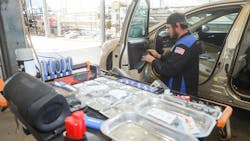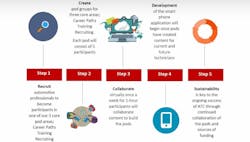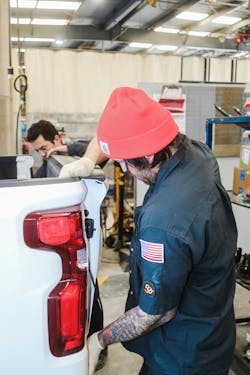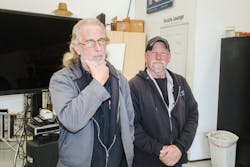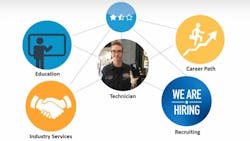As a shop owner for over 50 years, John Gustafson, co-founder and president of service/repair and collision repair provider Gustafson Brothers Automotive Services in Huntington Beach, California, is acutely aware of the technician shortage. It’s not a new problem, and there are a number of initiatives introduced by industry stakeholders to address it. But what if the industry could work together for its common goal? That’s why he formed the nonprofit Auto Talent Co-op to address the shortage for technicians in mechanical and collision repair shops.
“The intent of a co-op is to take all of the things that are being done well in the industry already in their own market, or their own silos, and bring them together,” Gustafson says.
“So, share them with the rest of the auto service community — collision and mechanical — and have a resource available so we can pool this talent and go out to the schools and recruit and attract and take the existing career paths that are already built and put them in place. You can go to an influencer, a student, or an entry-level technician and say, ‘Hey, if you choose this career, here’s what you can do.’”
Gustafson notes an entry-level technician can earn to a six-figure income, with no student debt, in just seven years “if they pay attention and adopt the core values, core focus, and pay attention to the people who are trying to help them.”
He hopes to duplicate the success of the internship and mentorship his own shop has proven successful. As a private pilot who flies every week between Nevada and the shop, Gustafson was drawn to the “ATC” abbreviation, but instead of air traffic control guiding pilots on the ground and in the air, this ATC is guiding tomorrow’s technicians.
'Turning Silos Into Pipelines'
Although he formed ATC as a (nonprofit) 501 (c)(3) in 2017, Gustafson has found it difficult to devote the time needed to gain much traction. So, earlier in the year he brought in automotive aftermarket veteran educator Jim Cokonis part-time as executive director to take ATC to the next level.
“When I started talking with John and the concept of ATC, he had the brainchild of having these five pods not to create new silos, but to have five identified areas of interest where people with expertise work on identifying, discussing, and solving issues related to this entire picture.”
Those five “pods” are career path, recruiting, training, a “must have,” and sustainability.
“We have to have recruiting that is sending out a positive message about who we are and what we do,” Cokonis says, “because there are lots of other trades and industries that gain support even from a government level because they have agencies and organizations, and in some cases, unions that support the training and development of the people entering the trade or becoming journeymen.”
He points to the State of South Dakota, which he says allots funds to all types of trades such as carpenters, plumbers, and electricians.
“But nothing is given to automotive because we are not organized.”
The duo’s vision is that each pod will include five people working in each action pod, for a total of 25 people working together at ATC from educators, industry organizations, and shop owners/operators.
“Those five areas of focus by a team basically take what we see in silos,” Cokonis says. “There are some beautiful programs out there, but they're in silos and nobody knows them.” The idea, Gustafson and he assert, is to “create synergy and turn these silos into pipelines.”
Replicating Success
Gustafson is seeking to replicate the success of the training and mentoring programs he's experienced at his in-shop Gustafson Brothers Training Academy (GBTA). I-CAR’s new Academy curriculum was beta-tested there, with the first batch of students having graduated at the end of July. GBTA’s curriculum incorporates the I-CAR curriculum and uses live work on either vehicles purchased from the salvage pool or on customers’ cars (under the guidance of Master Mentor Dave Baylor.) GBTA uses an Excel spreadsheet to track as technicians master various tasks.
“On the left are all these tasks you have to do to repair a collision-damaged car. And across the top, you have a visual of whether they helped, they did the work with guidance, or they did the work without guidance and they mastered it.”
Because crashes are so varied in how they damage a vehicle, the spreadsheet, which GBTA refers to as a transcript, will thus include dates and repair order numbers all over the document based on what vehicle repairs came in and were thus taught.
“We're working on a graphic right now to display at career fairs that shows core competencies, and we call it base camp,” Gustafson says. “Base camp is where an entry-level person would come in to understand soft skills, core values, and basic training. And we think we can get them out in the field working for a mentor technician within a year.”
Mentoring for Better Technicians
Baylor likens his position to that of an NFL coach. When a team, even with superstar players, turns in a mediocre performance, he says, that often calls for a replacement coach.
“What’s the first thing that coach does? He brings the whole team back to basic fundamentals of ball-handling and tackling. Wrap him up instead of hit him and don't carry the ball away ‘out here;’ use both hands and hold it close to your body. Even the ‘A-level’ technicians that have been doing it for 20 years, every once in a while, you have to bring them back to the fundamentals of how you fix a car.”
Once technicians complete their apprenticeship and are judged to be ready for mentorship, they are paired with an experienced mentor. Baylor acknowledges it’s an industry barrier that “technicians do not want to train their replacement. They’re looking at that guy as competition. They’re not looking far enough forward knowing they’re going to retire and, ‘Hey, this company is taking care of me. Let me see if can get somebody to take care of them after I’m gone.” Baylor handles much of the mentorship duties, but he calls on technicians to assist as mentors. Currently, it’s about a 2:1 ratio of mentees to mentor.
“I can do anything on a vehicle, but I’m not very good at mud work. That’s art to me, and they can elevate these apprentices better than I can in that area. So, they’re always coming over and helping out, but to find the one who actually wants to do that always is a little more challenging.”
Industry Involvement
Cokonis and Gustafson are still shaping some of the co-op’s focus as it continues to attract more members in each pod. One possibility is group members may decide to put effort and focus into developing connections between local shops willing to participate in the educational system that’s there and the local government.
“Because that’s the nexus of influence, control, and money, and we need to focus on making that work,” Cokonis says. “And perhaps the issue is that ATC seeks grants to fund some people working specifically on that, and that becomes a product of the ATC that becomes the ‘must-have.’”
Another option, he says, would be to write a grant approaching the government for funding to solve these issues.
“The government is looking at [career technical education] and other types of education in lieu of the four-year college degree for which graduates don’t even get a job in that career, and they have a bunch of student debt.”
To help illustrate the goal of the co-op, Gustafson points out a farm co-op works to help each individual farmer get his or her product to market.
“And the Auto Talent Co-op’s product is the right people and right seats in organizations to serve the motoring public. It is really as simple as it gets.”
He would like to see the co-op spread across the country and even the continent with its “cluster of good ideas” as the participants see how well it works to fill “empty seats” now and in the future, particularly with financial support from the industry.
“And we can do that because at Gustafson Brothers, we've been remarkably successful for 53 years growing every year. And this is my way of giving back, to have a process that will perpetuate our segment of the transportation economy.”
How to Get Involved
For more information, go to ATC's website at autotalentco-op.org. For more in-depth knowledge of ATC and its stakeholders, register for one of two user groups (closed and open) at the Diagnostic Network at diag.net.
About the Author
Jay Sicht
Editor-in-Chief, FenderBender and ABRN
Jay Sicht is editor-in-chief of FenderBender and ABRN. He has worked in the automotive aftermarket for more than 29 years, including in a number of sales and technical support roles in paint/parts distribution and service/repair. He has a bachelor's degree in journalism from the University of Central Missouri with a minor in aviation, and as a writer and editor, he has covered all segments of the automotive aftermarket for more than 20 of those years, including formerly serving as editor-in-chief of Motor Age and Aftermarket Business World. Connect with him on LinkedIn.
Don't miss Jay's next article or podcast. Sign up for FenderBender Today's Collision Repair News and ABRN eNews here.
